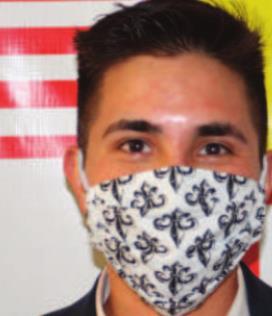Before we get into this column, I’d like to remind everyone to go vote!
November 3 is Election Day, and it does not matter who anyone votes for, this is a prized right that we have, and we should exercise it. And we must respect that everyone has different opinions on issues, much like mine to follow.
We have reached a point in our history where we are disgusted with the actions of our forefathers.
The past is filled with wickedness, but that does not mean we have the right to throw it in the proverbial shredder and pretend like it did not exist.
Slavery, wars, crusades, genocides... if you can think of it, we have done it. Humanity is an interesting species, more so because we can record our ac-tions, and actions that were once considered correct, proper, and necessary, are often looked upon today as inappropriate.
On Monday, in New Mexico, we celebrated Indigenous People’s Day, an opportunity to celebrate the rich and complex culture of those who lived here before the days of colonization. Indigenous People’s Day took the place of Columbus Day.
Columbus Day, at least as I was taught it, was a day to celebrate Christopher Columbus for discovering the New World. Now, I don’t even want to get into the discussion of “discovering” something that was already habited, but I do want to ask, why did we ever celebrate Columbus for discovering the New World in the first place?
Because he didn’t.
The first recorded European to visit the Americas was Leif Erickson, nearly 500 years before Columbus. Further, Columbus did not set a single foot in North America, not once. His fleet of ships enjoyed the beauty of the Caribbean islands and even Central America, but never the area that celebrated him for so long. http s ://www. wa shingtonpost. co m/news/answersheet/wp/2013/10/14/christopher-columbus-3-things-you-thin k-he-did-that-he-didnt/
Now, that is only part of why people do not like Columbus, but it is much the same with almost every other historical figure.
On Monday in the capital city of Santa Fe, protestors tore down an obelisk they say honored the murder of Native Americans. The obelisk stood in the center of the Santa Fe Plaza just a short walk from the Roundhouse, and it has an inscription which talks about the “heroes” who fought next to “savage Indians.” The word “savage” was eventually stripped from the 1866 monument, but the pain remained.
In much the same fashion there are statues of Confederate leaders and conquistadors and other people who, at the time, were considered heroes or people of particular nobility. There are contributions to history may not be seen as “good” and in some cases are seen as “evil.”
How do we reconcile with our problematic past?
Well, firstly, art is subjective. It only has the power we grant it; statues, stories, songs and tales are all art, even if they are nonfiction they are art, and we can choose what we want to do with it.
We can wipe away our history and pretend it never happened, or we can use our history as a springboard to do better. To acknowledge the past and the shortfalls of our forefathers to make the world a better place.
We can use the stories of violent war and slavery to make sure that it never happens again, or we can remain focused on the past which we cannot change and stew over it instead of taking action to stop issues across the world today, like the enslavement of Uyghur Muslims in China, or the murder of innocent civilians in Nagorno-Karabakh as it is assaulted by both Azerbaijan and Armenia. These are issues that we should be paying attention to, these are the wrongs we should be righting.
We can be bitter, or we can be better. We need to choose.

